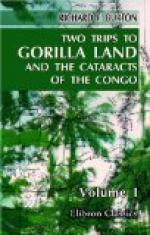The banana, when unripe, is white and insipid; it is then baked under ashes till it takes a golden colour, and, like a cereal, it can be eaten as bread. A little later it is boiled, and becomes a fair vegetable, tasting somewhat like chestnuts, and certainly better than carrots or turnips. Lastly, when softer than a pear, it is a fruit eaten with milk or made into beignets. I have described the plantain-cider in “Lake Regions of Central Africa” (ii. 287). The fruit contains sugar, gum, and acids (malic and gallic); the rind, which is easily detached when ripe, stains cloth with ruddy grey rusty colour, by its tannin, gallic, and acetic acids.
The Baraka Mission has had several out-stations. One was at a ruined village of Fan, which we shall presently pass on the right bank of the river. The second was at Ikoi, a hamlet distant about fifteen (not twenty-five) miles, upon a creek of the same name, which enters the Gaboon behind Point Ovindo, and almost opposite Konig Island. A third is at Anenge-nenge, vulgo Inenge-nenge,— “nenge” in Mpongwe, and anenge in Bakele, meaning island,— situated forty (not 100) miles up the main stream; here a native teacher still resides. The Baraka school now (1862) numbers thirty scholars, and there are twelve to fifteen communicants. The missionaries are our white “labourers;” but two of them, the Revs. Jacob Best and A. Bushnell, are absent in the United States for the benefit of their health.
My first visit to the Rev. William Walker made me regret my precipitate trip to Mbata: he told me what I now knew, that it was the wrong line, and that I should have run two or three days up the Rembwe, the first large influent on the southern bank of the Gaboon. He had come out to the River in 1842, and had spent twenty years of his life in Africa, with occasional furloughs home. He greatly interested me by a work which he was preparing. The Gaboon Mission had begun its studies of the many native dialects by the usual preparatory process of writing grammars and vocabularies; after this they had published sundry fragmentary translations of the Scriptures, and now they aimed at something higher. After spending years in building and decorating the porticoes of language, they were ambitious of raising the edifice to which it is only an approach; in other words, of explaining the scholarship of the tongue, the spirit of the speech.
“Language,” says the lamented Dr. O.E. Vidal, then bishop designate of Sierra Leone,[FN#19] “is designed to give expression to thought. Hence, by examining the particular class of composition”—and, I may add, the grammatical and syntactical niceties characterizing that composition—“to which any given dialect has been especially devoted, we may trace the direction in which the current of thought is wont to flow amongst the tribe or nations in which it is vernacular, and so investigate the principal psychical peculiarities, if such there be, of that tribe or nation.” And again he




